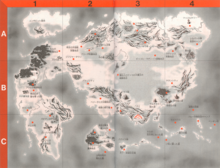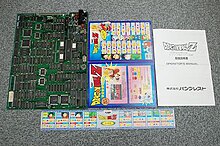Reception
Manga
Dragon Ball is one of the most popular manga series of all time, and it continues to enjoy high readership today. By 2000, more than 126 million copies of its
tankōbon volumes had been sold in Japan alone.
[94] By 2016, this number had grown to pass 156 million in Japan and 240 million worldwide, making it the second best-selling
Weekly Shōnen Jump manga of all time.
[95][96] Dragon Ball is credited as one of the main reasons for the period when manga circulation was at its highest in the mid-1980s and mid-1990s.
[97][98] For the 10th anniversary of the
Japan Media Arts Festival in 2006, Japanese fans voted
Dragon Ball the third greatest manga of all time.
[99]
In a survey conducted by
Oricon in 2007 among 1,000 people, Son Goku, the main character of the franchise, ranked first place as the "Strongest Manga Character of All Time."
[100]Goku's journey and his ever-growing strength resulted in the character winning "the admiration of young boys everywhere".
[2] Manga artists, such as
One Piece creator
Eiichiro Odaand
Naruto creator
Masashi Kishimoto, have stated that Goku inspired their series' main protagonists as well as series structure.
[101][102]
Manga critic
Jason Thompson stated in 2011 that "
Dragon Ball is by far the most influential shonen manga of the last 30 years, and today, almost every
Shonen Jump artist lists it as one of their favorites and lifts from it in various ways."
[103] He says the series "turns from a gag/adventure manga to an nearly-pure fighting manga",
[103] and its basic formula of "lots of martial arts, lots of training sequences, a few jokes" became the model for other
shōnen series, such as
Naruto.
[104] Thompson also called Toriyama's art influential and cited it as a reason for the series' popularity.
[103] James S. Yadao, author of
The Rough Guide to Manga, claims that the first several chapters of
Dragon Ball "play out much like
Saiyuki with
Dr. Slump-like humour built in" and that
Dr. Slump, Toriyama's previous manga, has a clear early influence on the series.
[105] He feels the series "established its unique identity" after the first occasion when Goku's group disbands and he trains under Kame-sen'nin, when the story develops "a far more action-packed, sinister tone" with "wilder" battles with aerial and spiritual elements and an increased death count, while humor still makes an occasional appearance.
[105] Yadao claims that an art shift occurs when the characters "lose the rounded, innocent look that he established in
Dr. Slump and gain sharper angles that leap off the page with their energy and intensity."
[106]
Animerica felt the series had "worldwide appeal", using dramatic pacing and over-the-top martial arts action to "maintain tension levels and keep a crippler crossface hold on the audience's attention spans".
[107] In
Little Boy: The Art of Japan's Exploding Subculture, Takashi Murakami commented that
Dragon Ball's "never-ending cyclical narrative moves forward plausibly, seamlessly, and with great finesse."
[94] Ridwan Khan from Animefringe.com commented that the manga had a "chubby" art style, but as the series continued the characters got more refined, leaner, and more muscular. Khan prefers the manga over the slow pacing of the anime counterparts.
[108] Allen Divers of
Anime News Network praised the story and humor of the manga as being very good at conveying all of the characters' personalities. Divers also called
Viz's translation one of the best of all the English editions of the series due to its faithfulness to the original Japanese.
[109] D. Aviva Rothschild of Rationalmagic.com remarked the first manga volume as "a superior humor title". They praised Goku's innocence and Bulma's insistence as one of the funniest parts of the series.
[110]
The content of the manga has been controversial in the United States. In November 1999,
Toys "R" Us removed Viz's
Dragon Ball from their stores nationwide when a
Dallas parent complained the series had "borderline soft porn" after he bought them for his four-year-old son.
[111] Commenting on the issue,
Susan J. Napier explained it as a difference in culture.
[111] After the ban, Viz reluctantly began to censor the series to keep wide distribution.
[112] However, in 2001, after releasing three volumes censored, Viz announced
Dragon Ball would be uncensored and reprinted due to fan reactions.
[112] In October 2009,
Wicomico County Public Schools in
Maryland banned the
Dragon Ball manga from their school district because it "depicts nudity, sexual contact between children and sexual innuendo among adults and children."
[








